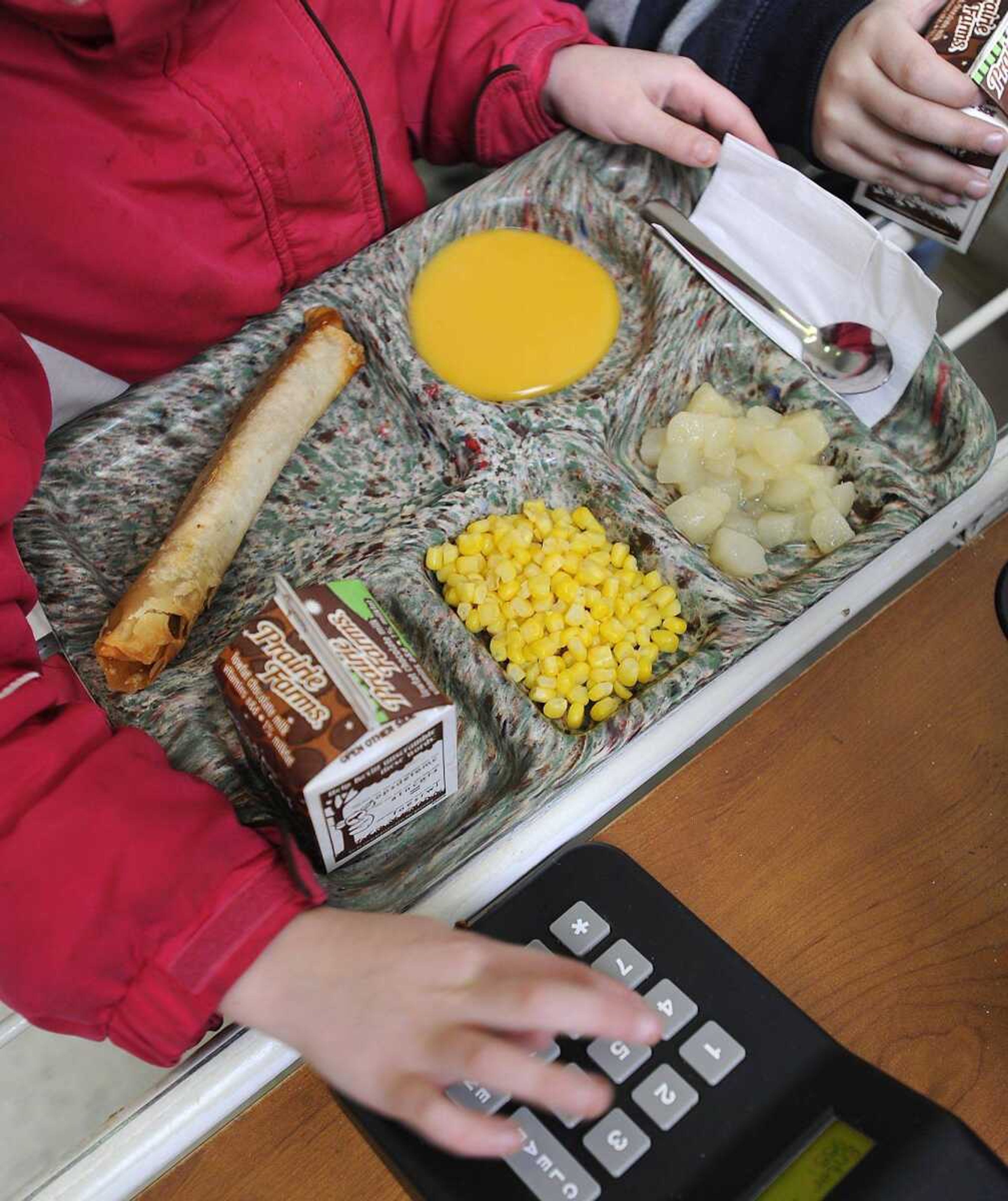The lunch hour arrived at Franklin Elementary School on Tuesday, and students were excited about one item on the menu -- the crispito.
Principal Rhonda Dunham said the crispy tortilla roll of chicken chili is the second most popular item her school serves, behind only pizza.
"Students love the Mexican food, plus it's easy and quick to eat," Dunham said. "When you find something that's really good and they like, that's when you capitalize on it. This is one they come back for seconds."
Serving meals is a balancing act for schools trying to comply with federal nutrition guidelines while preparing food that students want to eat. Dietitians say school meals are more healthful than they used to be but could be better.
According to Tyson Food Service's website, one crispito has 240 calories, with 130 of those calories from fat. A crispito has 14 grams of fat, or 22 percent of the recommended daily allowance, and 340 milligrams of sodium, or 14 percent of the recommendeded daily allowance based on a 2,000-calorie diet.
The Cape Girardeau School District, like others in the area, offers on most days an option with less fat and fewer calories, such as a turkey and cheese sandwich, in its elementary schools. As students enter the middle, junior and senior high school grades at Cape Girardeau, Jackson and other area schools, the choices expand to include a salad bar and selection of several homestyle vegetables.
Lisa Elfrink, coordinator of nutrition services for the Cape Girardeau School District, said that despite some dietitians' criticism of school lunches she believes her district does the best it can to meet the federal guidelines required to receive reimbursements for students who receive free or reduced-price meals. Those guidelines under the National School Lunch Act include offering meals with fruits, grain products and vegetables; a moderate amount of salt and sugar; and no more than 30 percent of calories from fat and less than 10 percent of calories from saturated fat. The act also requires schools to provide at least one-third of recommended daily allowances for calcium, iron, protein and vitamins A and C.
"Good nutrition is so important to the health and performance of our children," Elfrink said. "We've taken steps to make lunches more healthy such as eliminating sodas and serving more whole-grain products. In fact, when we switched to whole-wheat buns I thought we'd hear a lot of complaints from our children that we weren't using white buns, but I didn't."
Liz Aufdenberg, director of food services for the Jackson School District, said she's noticed that students who eat a well-balanced meal are better prepared that day, whether for sports, academics or responsibilities at home.
"If they eat a healthy lunch, it awakes their mind to grasp the knowledge presented to them that day," Aufdenberg said. "It's important to keep your mind alert and your body fit."
To ensure they meet proper nutrition, school districts such as Cape Girardeau and Jackson use NutriKids, a computerized program that allows officials planning meals to input all ingredients and food items for a particular week. The program will indicate whether, for example, calories, saturated fat and fiber are too high or low, allowing meals to be adjusted.
Nutrition difficulties
Dietitians such as Lori Pettet believe that while schools have raised the nutritional value of lunches, there is room to improve, by serving less processed foods and more whole grains and fresh fruits and vegetables.
"But I also understand that on the flip side there are some foods kids don't like, so it's a balancing act to try to get them to eat healthy foods," said Pettet, who has worked as a dietitian at Saint Francis Medical Center for 20 years. "... Unfortunately for a lot of kids, their best meals of the day are at school, depending on their family life and financial situation. Since that's the only food they're getting that day, we should make those meals as healthy as possible."
Aufdenberg said she would prefer serving mostly fresh meats, vegetables and fruits but that that's difficult to do.
"A lot of it has to do with higher labor costs and food handling safety if we were to serve only fresh produce and meat," Aufdenberg said. "If we would buy nonprocessed food, it would take extra time to brown it and heat it up and could pose a threat to safety of the food, as well as taking more time to prepare the food by our employees since we only have so much time available."
Some schools exceed the daily dietary guidelines, the not-for-profit Institute of Medicine found in a recent report. According ot the institute, a typical meal contains about 1,600 milligrams of sodium, about 1,000 more than the recommended amount.
The report recommended less sodium and more fresh fruits and vegetables and whole grains. Because of the increased cost, the report recommended a combination of higher level of federal meal reimbursement and more money for training food service workers.
Dietary solutions
Both school officials and dietitians agree that childhood obesity is a problem. Nearly one out of three children are obese, according to the National Center of Health Statistics.
To that end, the Obama administration has urged for the reauthorization of the Child Nutrition Act, which promotes increased participation in school food programs, more education about healthy eating, serving more healthy food and additional physical activity programs.
Debra Schumer believes that though school lunches are partly blame for the unhealthy lifestyle of children, parents should also bear some of the responsibility.
"Some of the focus needs to be on educating our children on appropriate portion sizes and physical activity," said Schumer, a registered and licensed dietitian and instructor at Southeast Missouri State University. "The prime time is in those younger years for exposing the proper choices to our children."
Pettet said that no matter how many programs exist at school or other places, nothing will change if they are not instituted inside the home.
"Our intake and habits learned as a child will affect us well into our older adult years," Pettet said. "Plus, we now have two people who work in the family, and that increases chances of eating out more often and cooking less at home.
"Obesity is increasing in our country, and that's scary," she said. "We need to do our best to instill a healthy lifestyle early on so they'll realize the importance of good nutrition when they reach adulthood."
bblackwell@semissourian.com
388-3628
Pertinent addresses:
301 N. Clark Ave., Cape Girardeau, MO
614 E. Adams St., Jackson, MO
1 University Plaza, Cape Girardeau, MO
Connect with the Southeast Missourian Newsroom:
For corrections to this story or other insights for the editor, click here. To submit a letter to the editor, click here. To learn about the Southeast Missourian’s AI Policy, click here.








